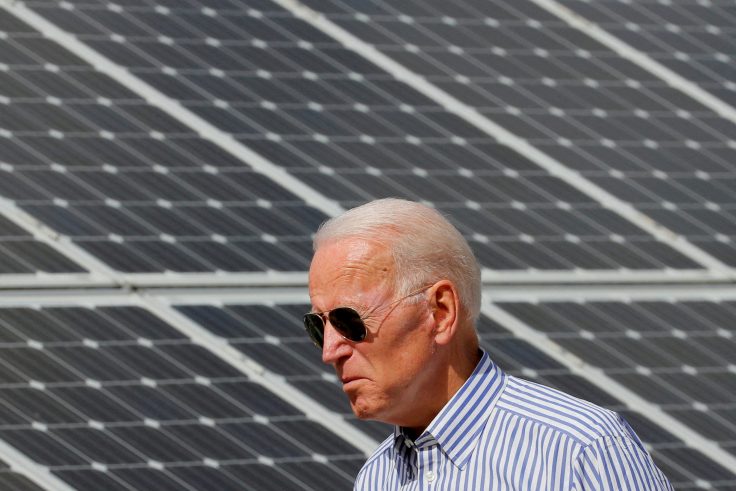President Joe Biden's aggressive climate regulations targeting fossil-fuel-fired power plants will create widespread electric grid instability and lead to mass blackouts impacting millions of Americans, according to a recent study commissioned by North Dakota's state government.
The research, conducted in May by the firm Always On Energy Research, concluded that the Environmental Protection Agency's recently finalized regulations are not technologically feasible and will foreseeably lead to the retirement of coal power generation units. Intermittent and weather-dependent green energy sources, such as wind and solar, will replace such retired generators, leading to unreliable conditions, the study found.
The study largely echoes concerns that have been voiced by the U.S. grid watchdog, the North American Electric Reliability Corporation; regional grid operators; and power utility companies. Four regional grid operators that oversee the infrastructure supplying power for 154 million Americans warned after the EPA regulations were first proposed last year that grid reliability would "dwindle to concerning levels" under the regulations. The Edison Electric Institute, the lead industry group representing U.S. electric companies, in late May joined a lawsuit that challenged the EPA's finalized regulations.
"Biden's Green Agenda is shutting down baseload power and is rapidly destabilizing our electrical grid. Electricity costs are up 30% under Biden already," North Dakota governor Doug Burgum (R.) told the Washington Free Beacon in a statement. "Prices will continue to skyrocket if he's re-elected as real power demand increases dramatically for the first time in decades—for chip manufacturing and new foundational industries like AI."
Burgum, a member of the North Dakota Industrial Commission, which commissioned the study, added that Biden's regulatory regime will reduce power supplies, leading to "higher prices AND less reliability."
In April, the EPA finalized the first part of a multi-pronged effort to curb greenhouse gas emissions produced by the nation's power sector. The regulations require existing coal plants to slash their carbon footprint 90 percent by 2032, which could force the vast majority of such plants across the country to shutter over the next two decades. They further require significant emissions reductions for new natural-gas-fired power plants that operate more than 20 percent of the time.
The finalized regulations are poised to have a particularly acute impact in Midwestern states such as North Dakota, where coal-fired power plants produce more than half of all electricity generated and where the four largest power plants are all coal-fired. North Dakota is also the sixth-largest coal-producing state in the country.
According to Always On Energy Research, the rules' economic consequences include increasing the cost of compliance for coal plant operators, reducing competitiveness with alternative power sources, expediting the rate of coal retirements, resulting in higher electricity prices, and causing supply chain issues for industries reliant on coal.
"The Finalized Rule will increase costs, which, compounded with inflation, will negatively impact the affordability of electric and gas services, resulting in a disproportionate effect on low-income citizens," the study stated. "Given the high rural populations in North Dakota, pricing low-income citizens out of a reliable energy source creates an economic and social justice issue with devasting [sic] impacts on North Dakotans' lives."
In addition, under EPA's plans, coal plants—considered dispatchable power, or power that can quickly be turned on in times of high electricity demand—will largely be replaced by new solar and wind power generators, which are highly dependent on proper wind conditions.
Solar panels, for example, produce just 25 percent and wind turbines produce 34 percent of their listed capacity, according to the Energy Information Administration. Coal and natural gas plants, meanwhile, respectively produce 49 percent and 54 percent of their listed capacity.
Factoring in that disparity, Always On Energy Research concluded the grid across the majority of the Midwest would experience nearly 9 million megawatt hours of unserved load, leading to blackouts costing tens of billions of dollars.
"The EPA power plant rule is exactly the wrong thing to be doing for grid reliability right now," Paige Lambermont, a research fellow at the Competitive Enterprise Institute, told the Free Beacon. "To be intentionally closing and, essentially, banning the facilities that are keeping the grid functioning while, at the same time, in other ways, encouraging the penetration on the grid of things like wind and solar that are making the grid less reliable is going to have incredibly poor aftereffects."
Nationwide, natural gas plants generated roughly 43 percent of total electricity produced in 2023 while coal plants generated another 16 percent, according to additional Energy Information Administration data. By comparison, wind power generated 10 percent of total electricity in the United States, and solar produced less than 6 percent.
The EPA is expected to finalize a second batch of regulations cracking down on existing natural gas power plants in the coming months.
Democrats and climate advocates have long targeted the power sector as part of their effort to reduce pollution and fight global warming. According to EPA data, electric power generation in the United States is responsible for 25 percent of total nationwide emissions, only behind the transportation sector, which produces roughly 28 percent of total emissions.
EPA spokeswoman Angela Hackel told the Free Beacon that "over decades EPA regulations like the Mercury and Air Toxics Standards and Good Neighbor Rule have achieved important reductions in pollution from electricity generation while supporting reliability."
"This rule will do the same," Hackel said. She added that the EPA is reviewing the North Dakota study.
